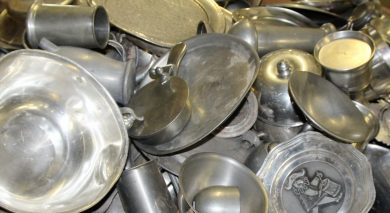
PEWTER
Go To → Silver Plate Go To → Sterling
Silver Plate Buyers is always purchasing pewter material of various quantities. From full trailers to small boxes, we buy it all.
Pewter material comes in many categories such as Hollowware (plates, spoons, tankards, beer steins), Jewelry, Decorative Items (figurines, replica coins, pendants, statuettes, models). Below is a guide to help you figure out what you may have..
What is Pewter?
Pewter is a soft metal alloy, normally made up of 86-99% tin, with the rest being made up of antimony, bismuth, copper and on occasion, but less likely today, lead. Silver in rare occasions may be used. It has a low melting point, around 338-446 Degrees Fahrenheit, depending on the exact mixture of metals.
It was first used around the beginning of the Bronze Age in the Near East. The earliest piece of pewter found in an Egyptian tomb from 1450 BC. It was readily used in the ancient world by the Egyptians and later by the Romans, but grew in popularity in Europe in the Middle Ages.
Older pieces with higher lead content are heavier, tarnish faster, and oxidation gives them a darker silver-gray color. Modern pewter is available that is completely free of lead, although some pewter containing lead is still being used to produce products that do not normally come in contact with the human body, such as statuettes, models, or figurines.


How Can I Tell If My Item Is Pewter?
Typically there are markings on the bottom of your piece that will tell you if it is Pewter. Look for words like Pewter or BM (British Metal). Pewter is generally darker, softer and duller than silver. Another way it differs from silver is normally it is less durable, bends and dents easily. Please Note: If you see the marking PewterX, Wilton, Wilton Armetale, or Stede, then the item is not Pewter, it is actually Cast Aluminum.
Another good test is to check if a magnet sticks to the item. If it does, then that indicates that the item is made of steel or iron, and not pewter.